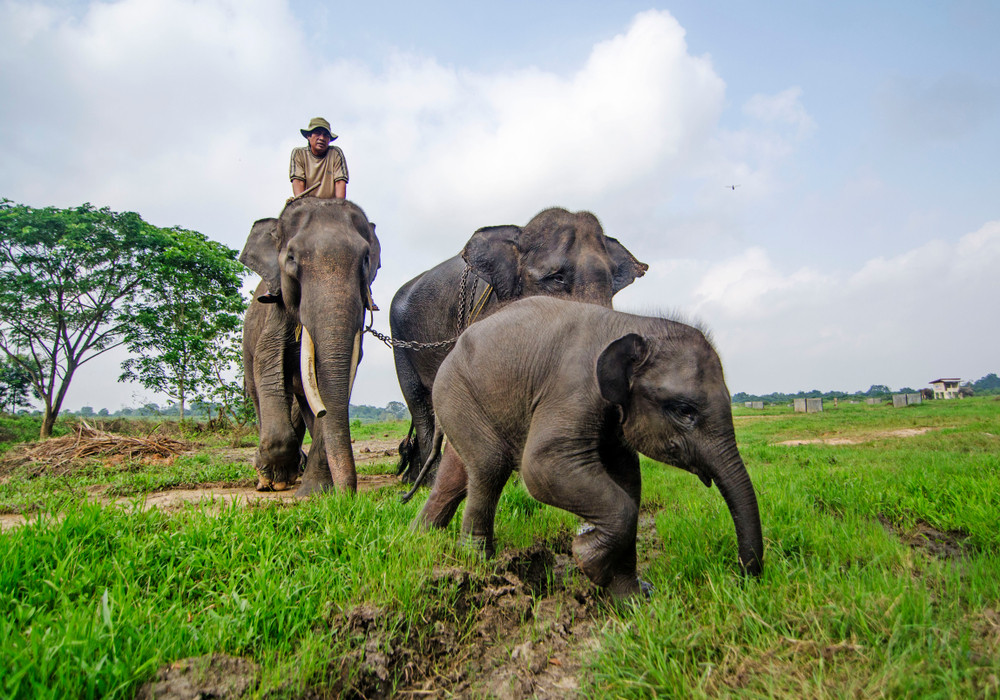Popular Reads
Top Results
Can't find what you're looking for?
View all search resultsPopular Reads
Top Results
Can't find what you're looking for?
View all search resultsElephant in the village: Jambi villagers struggle to keep giant animals away
A human-elephant conflict has been ongoing in Semerantihan village for years.
Change text size
Gift Premium Articles
to Anyone
T
he last time Usman and other residents of Semerantihan village in Sumay district, Tebo regency, Jambi, had a good night’s sleep without worrying that a herd of Sumatran elephants would roam into their residential area was four years ago.
Semerantihan village is located within the 508,000-hectare Bukit Tigapuluh ecosystem that stretches from Riau to Jambi. The ecosystem is considered to be the last sanctuary for several endangered species, including the Sumatran orangutan, tiger and elephant.
Every night, villagers go on patrol around the village to drive away the elephants and prevent them from entering their local plantation. Usman said a herd consisting of at least 30 elephants regularly circled the village.
“These elephants like to come into our plantation. They eat or stomp on our crops,” Usman told The Jakarta Post recently.
Even though they are suffering from losses as a result of the damaged crops, Semerantihan villagers can do little to change the situation. The Sumatran elephant was declared an endangered species by both the international community and the Indonesian government.
The International Union for Conservation of Nature (IUCN) included the species on its red list, calling it “critically endangered”. Meanwhile, the elephant is also included on a list of protected animals in a 2018 Environment and Forestry Ministerial Regulation on protected flora and fauna.
Villagers found killing the endangered elephant can be prosecuted for violating the 1990 law on natural resources and ecosystem conservation. Under the law, villagers can face up to five years’ imprisonment and Rp 100 million (US$7,005) in fines for killing the mammal.
Aware of the consequences of poaching, the village residents have on several occasions tried to scare off the animals by making loud noises.
However, their attempts are often fruitless, as the elephants regularly return to the village and local plantation, presumably to find food, leaving the villagers frustrated.
“Our ancestors have lived here for dozens or even hundreds of years, but we never heard a story about elephants from our parents,” Usman said, adding that the residents lacked knowledge on how to drive the elephants away.
Udin, a resident of Suo-Suo village – located about a two-hour drive from Semerantihan – referred to the elephants “harmful pests” for destroying not only plantations but also a hut belonging to one of the residents.
“I don’t know how, but we have to drive these animals away,” Udin said.
Wisma Wardhana from the Cakrawala volunteer organization said a thorough examination on where the elephants came from and their numbers and habitat was necessary.
“Therefore, authorities and residents can decide on proper regulation and treatment in the area,” Wisma said.
It is common for elephants to enter villages in Sumatra. The rampant conversion of forests and land into plantations is thought to be the main cause of human-elephant conflicts across the country.
Data from the World Wildlife Fund (WWF) Indonesia in 2015 showed that Indonesia had the highest number of human-elephant conflicts in Asia.
“The conflicts are not only damaging to the [human] community but also threaten the elephants’ existence, because the solution to such conflicts often tends to harm the elephants,” WWF wrote.
Jambi Natural Resources Conservation Agency head Rahmat Saleh Simbolon said the agency and the two international institutions had been working for several years to map out the elephants’ migratory routes.
“The only way to prevent these animals from expanding their roaming area is to install wire fences,” Rahmat said.
The agency previously erected a 15-kilometer electrified wire fence and is planning to add another 10 km of fences.
“The electricity is not harmful to the elephants, other animals and humans due to its low voltage. It will only give a small shock,” the agency head said.
In addition to adding fences, the agency formed working groups in nearby villages that consists of residents.
“They have been educated on how to drive the elephants away,” Rahmat said, adding that it should also educate villagers on the endangered status of the species. (kuk)










